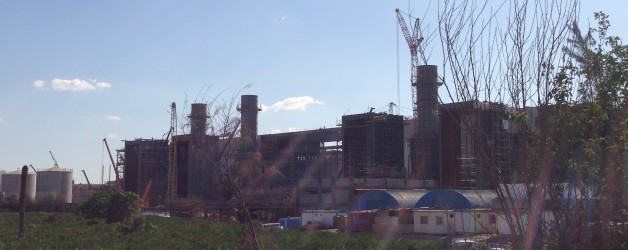This post is also available in: Arabic
A view of the Giza North Power Plant (GNPP) Project Site. Original image by Katelyn Gallagher.
Giza North Power Project
Country: Egypt
World Bank Funding: US$840 million
Giza North Power Project two-page overview BIC 2014 (Page 3)
The World Bank is providing $840 million in investment lending to this $2.2 billion natural gas-fired power plant. The World Bank’s funding for the Giza North Power Project also funds an associated pipeline to carry the natural gas to fuel the plant, as well as an electrical transmission line to carry the electricity produced to the national grid.
The project is located approximately 30 km to the northwest of Cairo, and is situated on 72 feddans (approximately equal to 72 acres) of fertile agricultural land in the Nile Delta, in water-scarce Egypt where less than 4% of land is arable. As a result of dramatic population growth in Egypt over the last three decades, demand for energy has increased and Egypt has experienced energy shortages. The World Bank has responded to the Government of Egypt’s requests to build several huge power plants, including the Giza North Power Plant, as a result of this energy crisis. However, these plants have not benefited from a clear and transparent energy strategy on the part of Egypt’s government, which is apparent in the location of the Giza North Power Plant project on scarce agricultural land, along the Nile where population density is already a concern. Conversion of agricultural land for the purpose of infrastructure development and continued over-development along the Nile are short-sighted answers to an energy problem that affects millions of Egyptians.
During the construction of the Giza North Power Plant in 2012, local communities presented various concerns including issues related to water and land rights, loss of livelihood, inappropriate compensation, and coercion to the implementing company and to the World Bank project management, without finding a solution. In February, 2013, 6 Egyptian civil society organizations, two regional civil society networks, and 35 affected community members raised their concerns to the Inspection Panel, which is the World Bank’s independent accountability mechanism. The Inspection Panel completed an eligibility visit and report, which acknowledged that the project had resulted in harms to the community.
Following this meeting and subsequent communication with the World Bank office in Cairo, complainants were granted access to a grievance mechanism specific to this project. Through this grievance mechanism and mediation by the World Bank, farmers and community members received compensation for the harms they faced and nearly all complaints have been satisfied at this point. BIC condensed case study research and materials developed by two Egyptian partner organizations with support from BIC on the Giza North power plant project into a two-page briefer.
Various concerns have been raised by communities and civil society organizations surrounding the Giza North Power Plant project, including:
• Water: Giza North Power Plant is built in an agricultural area in between the Rashid branch of the Nile River and the Baheiry canal, which are both part of the important water supply that irrigates the agricultural land in the Nile Delta. The Rashid Branch and the Baheiry canal also represent an important livelihood for fishermen and farmers living and working in the surrounding areas. The Giza North Power Plant, when operational, will draw water from the Baheiry canal for cooling purposes and will return the water to the canal downstream at a higher temperature. During construction of the intake and output structures, which themselves obstruct part of the canal, the canal’s flow was disrupted. Local fishing communities have reported significant impacts to their livelihoods due to decreased availability of fish in the waters surrounding the plant, and due to damages to their nets and boats from construction equipment. Farmers whose lands border the Giza North Power plant project reported a significant reduction in the groundwater feeding their wells during the construction of the power plant, and were not properly compensated according to the size of land and the losses of each landowner and farmer.
• Land: The 72 feddans of the project site were purchased by the implementing company from the owner of the land who had put the parcel of land up for sale. Tenants and laborers who had been residing and working on the land who had customary contracts to work the land were forced to leave the land and lost their livelihoods without compensation at the time construction on the plant began. The construction of this power plant converts a significant plot of scarce agricultural land to industrial land, when the site at the outer edge of the fertile Nile Delta land and is within 20 kilometers of desert land. The construction of the plant is also drawing increased numbers of people to housing, shops, and other buildings on the land surrounding the plant to feed on the increased traffic to the area, which will increase the total agricultural land lost.
• Right of way: After some farmers refused compensation for their land to be used for construction of towers for electricity transmission lines, the Egyptian government issued an official decree declaring that the land could be taken by force, which goes against the World Bank’s Safeguard policy on involuntary resettlement.
Official Documents
Inspection Panel complaint, February 21, 2013, World Bank Inspection Panel (External Link)Inspection Panel Eligibility Report, June 10, 2013, World Bank Inspection Panel (External Link)
Management response, May 07, 2013, World Bank Inspection Panel (External Link)
Useful Websites
World Bank GNPP project page, World Bank (External Link)Inspection Panel GNPP project page, World Bank (External Link)
BIC Senior Program Associate, Middle East & North Africa Program
+1 (202) 624-0639
kgallagher@bankinformationcenter.org

